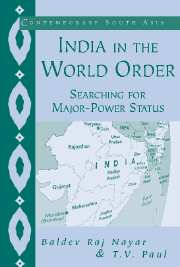Book contents
- Frontmatter
- Contents
- Acknowledgements
- 1 Introduction: India and Its Search for a Major-Power Role
- 2 Major-Power Status in the Modern World: India in Comparative Perspective
- 3 The Constraints on India: International and Domestic
- 4 Nehru's Grand Strategy for a Major-Power Role, 1947—1964
- 5 Strategy in Hard Times: The Long March for Capabilities, 1964—1990
- 6 After the Cold War: Adaptation, Persistence and Assertion, 1991—2001
- 7 Conclusions: India and the Emerging International Order
- Bibliography
- Index
6 - After the Cold War: Adaptation, Persistence and Assertion, 1991—2001
Published online by Cambridge University Press: 05 July 2014
- Frontmatter
- Contents
- Acknowledgements
- 1 Introduction: India and Its Search for a Major-Power Role
- 2 Major-Power Status in the Modern World: India in Comparative Perspective
- 3 The Constraints on India: International and Domestic
- 4 Nehru's Grand Strategy for a Major-Power Role, 1947—1964
- 5 Strategy in Hard Times: The Long March for Capabilities, 1964—1990
- 6 After the Cold War: Adaptation, Persistence and Assertion, 1991—2001
- 7 Conclusions: India and the Emerging International Order
- Bibliography
- Index
Summary
The end of the Cold War, marked by the unraveling of the Soviet bloc in 1990 and more dramatically by the unexpected disintegration of the Soviet Union in 1991, transformed the nature of the international system from a bipolar order to a semi-unipolar one that was now presided over by the US as the sole superpower. The event also sparked a profound resurgence of US, and in a broader sense Western, triumphalism. With its awesome capabilities, including those emergent from the revolution in military affairs (RMA), the US was, in the aftermath of the end of the Cold War, now determined to remain the sole superpower. This determination was set forth in an emphatic fashion in the draft Defense Planning Guidance Paper of 1992:
Our first objective is to prevent the reemergence of a new rival, either on the territory of the former Soviet Union or elsewhere. … This is a dominant consideration … and requires that we endeavor to prevent any hostile power from dominating a region whose resources would, under consolidated control, be sufficient to generate global power. … Our strategy must now refocus on precluding the emergence of any potential future global competitor.
Following the lead of the guidance paper, one US scholar demanded, more colorfully, that the US “be the global hegemon of the regional hegemons, the boss of all the bosses.” The US political leadership itself was not far behind in expressing this self-perception of the US as the one indispensable nation.
- Type
- Chapter
- Information
- India in the World OrderSearching for Major-Power Status, pp. 203 - 248Publisher: Cambridge University PressPrint publication year: 2002



